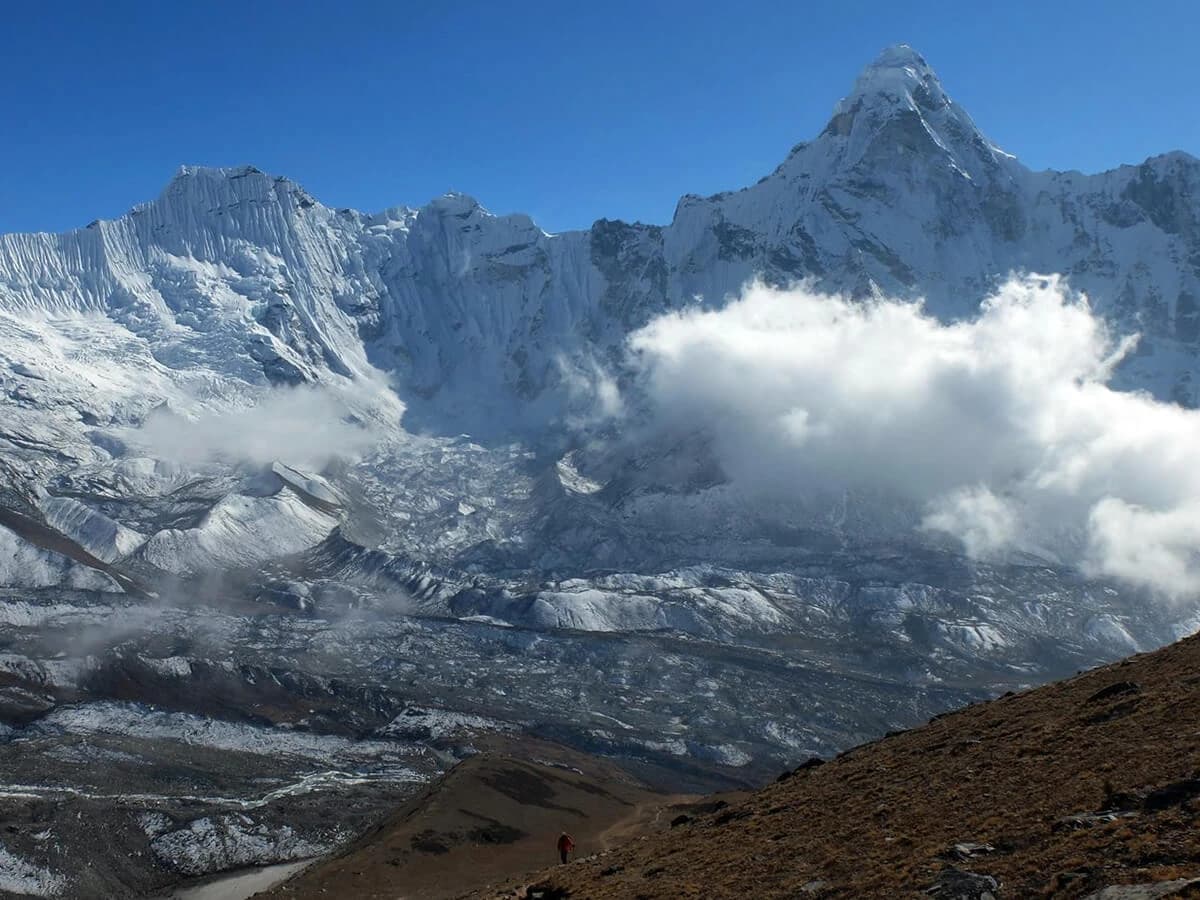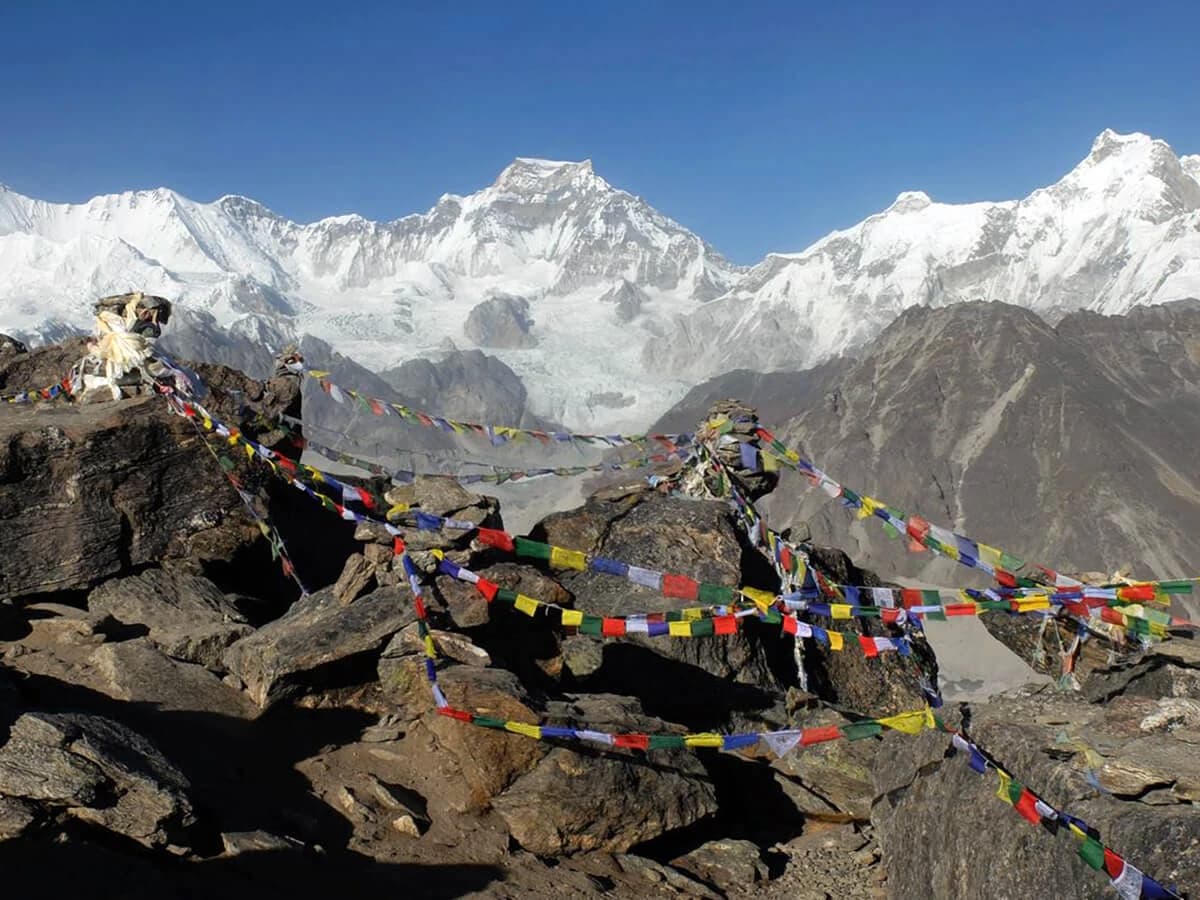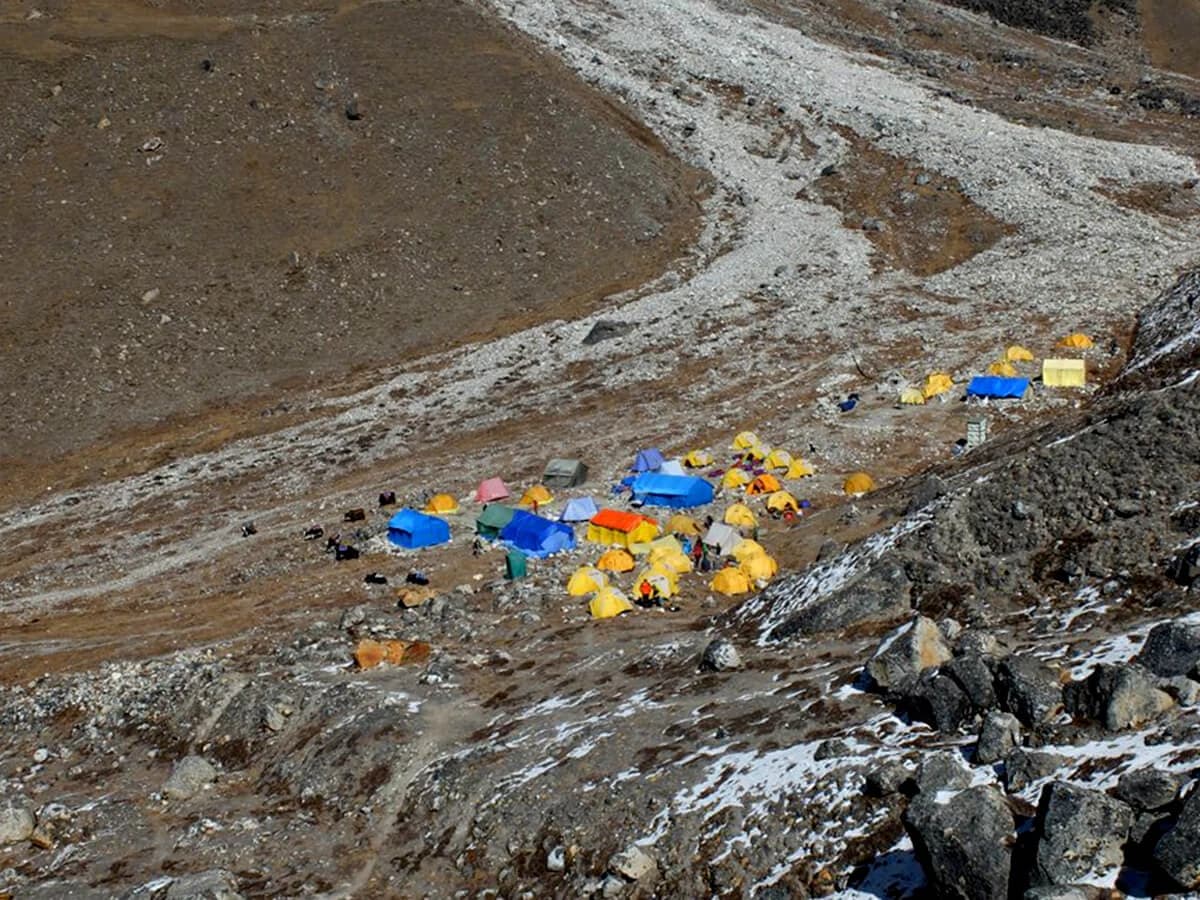The Everest Base Camp Cho La Pass Trek is one of the most adventurous trekking routes in the Everest Himalayas of Nepal that goes beyond the classic Everest Base Camp Trail. In 18 days, trekkers get to reach two of the major highlights of the iconic Khumbu/Everest region of Nepal, Everest Base Camp (5,364m) and one of the highest mountain passes in the world, Cho La Pass (5,420m). Beginning traditionally with an adventurous flight to Lukla from Kathmandu, the Everest Base Camp Cho La Pass Trekking 18 Days itinerary offers you a unique experience of alpine walking with beautiful scenery all around, including all the usual sights of the area, such as majestic mountain views including Mount Everest, Lhotse, Ama Dablam, Nuptse, Thamserku, Pumori, and Cho Oyu, followed by other neighboring snow-capped mountain giants.
This trip to Everest combines a trek to Everest Base Camp with Cho La Pass, which features a trekking trail slightly more technical than the classic Everest Base Camp hiking route, and is just the right choice for adventurous and nature enthusiasts, which opens the door to some of the most awe-inspiring experiences in the Himalayas. Though the highest point you will reach is 5,545m at Kala Patthar, the Cho La Pass serves as the most challenging section of this combined trek to Everest Base Camp and Cho La Pass and demands commendable physical fitness, resilience, and mental makeup. That is why, in general, the 18 days Everest Base Camp Cho La Pass Trek itinerary is best done by seasoned trekkers keen to push themselves both physically and mentally.
Along the way, trekkers can anticipate full exploration of warm Sherpa culture, traditions, and their hospitality, followed by a unique perspective of the Everest Himalayas in each step, while the high-altitude Everest viewpoints like Kala Patthar and Gokyo Ri ensure a 360-degree panorama like never seen before, including that from Everest Base Camp and Cho La Pass, the ultimate viewpoint for this combined hike to Everest Camp and Cho La Pass. So do not miss our early and group discounts on Everest Base Camp Cho La Pass Trekking Cost for 2025 and 2026. While our package cost, i.e., the Everest Base Camp Cho La Pass Trek Cost, covers expenses for all essential trekking logistics, including food, accommodation, and transportation (both drive and domestic flight), get ready to embrace the raw Himalayan wilderness.
What can you expect during the Everest Base Camp Cho La Pass Hike?
The Everest Base Camp Cho La Pass Hiking is an amazing adventure that lets trekkers access one of the turquoise hidden gems of the Everest Trekking Region of Nepal, Gokyo Lakes and Valleys, via the challenging Cho La Pass. This trek is ideal for trekkers who want an amazing Himalayan experience, to dive into the rich culture of Sherpas, also called the “Tigers of snow” for their extraordinary alpine climbing and trekking skills, and are willing to push themselves both mentally and physically. The journey begins with a flight to Lukla, followed by interesting trails through the Sherpa villages over there, like Namche. The first half of the hike includes reaching the Everest Base Camp; then comes the thrilling part of the trek, which is passing the Cho La Pass, which has a steep and icy trail requiring physical fitness and acclimatization, but the alpine scenery will make up for it, followed by a scenic and adrenaline-rushing serene reach to Gokyo Lakes.
Along the way, you will get a chance to immerse yourself in the rich Sherpa culture, and specifically in Tengboche, home to the largest Buddhist monastery of the region, Tengboche. You can expect comfortable accommodation with traditional Nepali food and some hot beverages during your trek, which will help you gain energy. The Everest Base Camp Cho La Pass trek, in short, is your gateway to mountains, which delivers an unforgettable journey packed with challenges, out-of-this-world mountain views, and warming cultures, all fostering a life-changing experience. This trek combines physical challenges with majestic views, making it perfect for adventure and a meaningful connection with the nature and culture of Nepal.
Everest Base Camp Cho La Pass Trek - Is this trip right for you?
The Everest Base Camp Cho La Pass Trekking is taken as a moderate to challenging Himalayan voyage and is not without high-altitude challenges. However, almost every individual with a good level of physical fitness who is used to high-altitude hiking conditions with a backpack can complete the journey. Combining the classic route of Everest Base Camp with one of the least explored paths, Cho La Pass, it’s perfect for those craving a mix of natural beauty, cultural immersion, and added raw Himalayan wilderness near the infamous Everest Base Camp Trek route. To simplify, if you are not suffering from any serious health issues and begin preparing yourself both physically and mentally at least a month before, or, better, begin three months prior, the Everest Base Camp Cho La Pass is a fantastic adventure of a lifetime, and it is up to you to decide whether it will suit you or not.
What should you pack for the trek to Everest Base Camp and Cho La Pass?
Packing light and efficiently is key to a comfortable combined trip to Everest Base Camp (EBC) and the Cho La Pass. It is utmost that you pack properly without overloading and have your back in varying altitudes and temperatures. Layering clothes means you are ready to face the challenge of the frequently changing weather and start with 2-4 moisture-wicking base layer shirts (preferably long-sleeved) and two thermal tops for higher altitudes. In addition, it is good to have a jacket as a mid-layer, followed by a down, water- and windproof jacket with a hood for extra protection. For the lower part, you pack some quick-drying trekking pants along with some trekking half pants. A warm beanie or a sun hat with a neck gaiter or buff keeps your head protected from extreme UV and cold wind, while insulated gloves are to prevent frostbite on the hands. For feet, you will need a good pair of fitted waterproof trekking boots with good ankle support, especially when you are traversing the route to the Cho La Pass from Everest Base Camp.
In addition, some pairs of hiking socks (wool or synthetic) to keep feet dry, and for the evening, you will not want to miss a pair of sandals. Gaiters are crucial when you are trekking to Everest Base Camp and Chola Pass in the snowy season, winter. For a comfortable night in high altitude where the temperature can get below freezing point, sleeping bags are a must, as the one provided by the tea house alone might not be enough. A waterproof duffle bag of about 25-30 liters to carry daily essentials like trekking poles, reusable water bottles with water purifier tablets, headlamps with some spare batteries, UV-protected sunglasses, high-SPF sunscreen, lip balm, and a quick-dry towel, along with a first-aid kit containing band-aids and medicine for diarrhea and altitude sickness, is a must. Toiletries such as toothbrushes and toilet paper are also necessary for improved hygiene while you are on a hike to Everest Base Camp and Cho La Pass.
How to prepare yourself for this trek to Everest Base Camp and Cho La Pass?
To prepare for the Everest Base Camp (EBC) Cho La Pass trek, you will need to be physically fit and mentally strong. Being mentally prepared means keeping your expectations realistic and adjusting for basic accommodations during the trek. To be physically prepared, you should start training yourself 5-7 weeks before the official trek departing day to Everest Base Camp and Cho La. Whether you are a beginner or a seasoned trekker, if you are well-prepared with activities like running, cycling, swimming, climbing stairs, and hiking with a 7-9 kg backpack on your back, followed by proper acclimatization while on the trail, anyone with commendable physical fitness can complete the journey.
Include training that builds your core strength and stamina, focusing on legs for stability on rocky and steep trails. You can also do yoga, which is beneficial for flexibility and balance. Mental preparation is also another essential part of your successful journey and is essential to understand the trekking trail to Everest Base Camp Cho La Pass, including extensive trekking days for longer hours, basic accommodations, and unpredictable Himalayan weather.
Breathtaking Adventure at every step experience: Trek to Everest Base Camp, Cho La Pass
For those seeking a lifetime experience, trekking to Everest Base Camp and Cho La Pass offers an unforgettable adventure journey with some breathtaking views of the mountains. This amazing trail takes you beyond your imagination through the Khumbu region and reaches at least three of the major highlights of the region: Everest Base Camp, Cho La Pass, and Gokyo Lakes. Based on the 18 Days Everest Base Camp Cho La Pass Trek itinerary, right from the trek starting point, i.e., Lukla, also called the gateway to the Everest Himalayas, the serene natural beauty and rural Nepalese culture are so profound that they are more refined as you walk through Namche Bazaar, Dingboche, some ancient monasteries, and Sherpa villages, while the panoramic views of mountain peaks like Mount Everest, Makalu, and Lhotse predominate the scenic landscapes.
The shimmering glaciers bless you from Everest Base Camp, and as you head to the Cho La Pass. The teahouses dotted in between villages, preserving ancient Himalayan cultures hidden from the rest of the world, soon come together for you to realize the journey to Everest Base Camp and Cho La Pass is more than physical endurance and is also a chance to reconnect with nature spirituality, often fostering a transformative Himalayan voyage like never before. To conclude, while there is no doubt that the Everest Base Camp Cho La Pass Trip is a challenging endeavor, Skybound Adventure with our essential trekking and climbing gear and equipment free of cost covered by the Everest Base Camp Cho La Pass Trekking Cost, including for 2025 and 2026, ensures you a safe, secure, and hassle-free trekking experience. Reserve your seat now!


